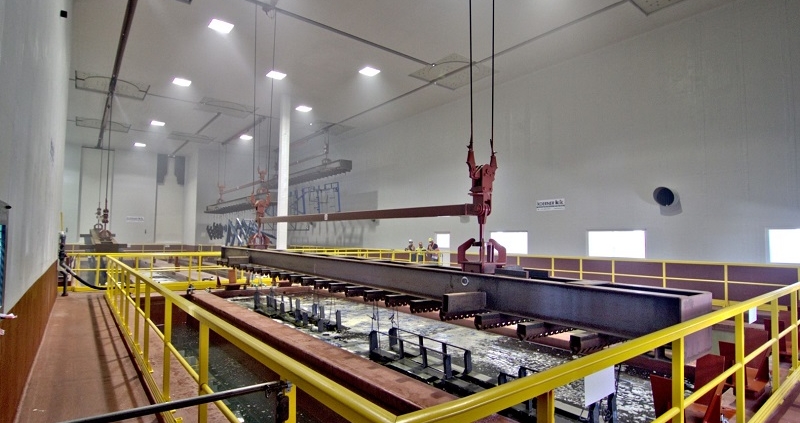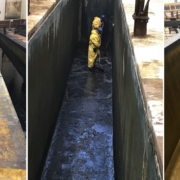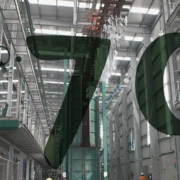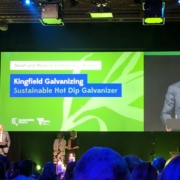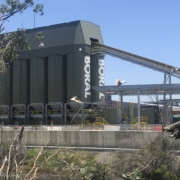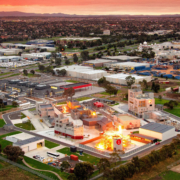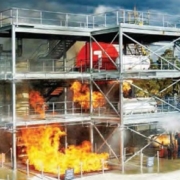Advanced Pre-Treatment keeps plant clean & lean – Steel Magazine article, March 2017
Proving that environmental sustainability and business efficiency can go hand in hand, the fully automated and sealed pre-treatment area of Kingfield Galvanizing’s larger new plant in Melbourne allows staff to be re-deployed to areas of the business and turn up the heat to achieve much greater throughput.
Commissioned in April 2015, the plant expansion more than tripled its working floor area to 7500sqm and is designed to support 30,000 tonnes of throughput a year.
It involved 490 tonnes of steel and an additional 290 tonnes was used for installation of the equipment (pre-treatment room walls, materials handling system support structures). Every piece of structural steel in the building is galvanized.
Kingfield Galvanizing Chief Executive Officer, Steve Laussen said the new plant introduces recycling initiatives, state-of-the art manufacturing processes and improved workplace safety to build greater capacity with at least double the throughput of the old plant.
“It allows a more diverse product mix with a longer and deeper bath, greater quality control through clearly defined and measured pre-treatment recipes, increased yard capacity and under-cover storage and overall improved tracking of individual products, he said.
But the most significant improvement Mr Laussen said was the incorporation of a fully enclosed and automated pre-treatment area. The enclosed facility ensures all corrosive fumes from pre-treatment processes are captured and cleaned through a wet scrubber.
The HDG process is basically the same across all plants with most of the steel going through a cleaning process with a degreasing agent (sodium hydroxide), acid (hydrochloric acid) and a flux (zinc ammonium chloride) before dipping in molten zinc.
“The design of the enclosed pre-treatment area is that as doors are opened or closed for product to enter or leave, extraction fans automatically increase the drawing of fumes so that no fumes leave the room and don’t risk impacting the rest of the facility,” he said.
“It allows us to heat our pre-treatment chemicals to increase their efficacy and lifespan without the extra fumes creating corrosion.
“Most importantly, we achieve greater life from our chemicals, using less chemicals per tonne of steel galvanized as well as decreasing our volume of waste chemicals per tonne of steel galvanized. Throughout the pre-treatment process we use recycled heat from the HDG furnace, re-use acid cleaned from the air in the pre-treatment tanks and reduce waste via automated processes.”
He said the key benefit to staff of the enclosed pre-treatment room is that plant is a much more enjoyable and safer environment to work in.
“The key safety elements come from the automation whereby jig movements from the moment a jig has been prepared for pre-treatment to when it is to be dipped in the bath does not require manual handling,” he said.
“The zones through which the jigs move exclude human traffic and if a staff member does have to enter these areas, the material handling system shuts down.”
He said the need to build the new plant required investigation into what had taken place recently in the local markets as well as overseas. The requirement of the EPA to create a pre-treatment facility that met ‘world best practise’ further influenced the investigation.
They toured European facilities to inspect large capacity plants (>40,000T/year) where the product range was small as well as smaller plants that were galvanizing a broad range of products similarly to in Australia.
“The general view within Australia is that an automated plant with enclosed pre-treatment is too expensive to build and could not efficiently process the diverse product range that HDG businesses in Australia have to accommodate,” he said.
“All plants utilised automation and enclosed pre-treatment to achieve operational efficiency, high product quality and with significantly reduced maintenance costs. The opportunity to meet with plant owners, production managers and general staff confirmed the benefits of the investment. We saw the opportunity to bring this technology to Australia and achieve the same outcomes, while delivering a safer and more sustainable workplace for our galvanizing team.”

